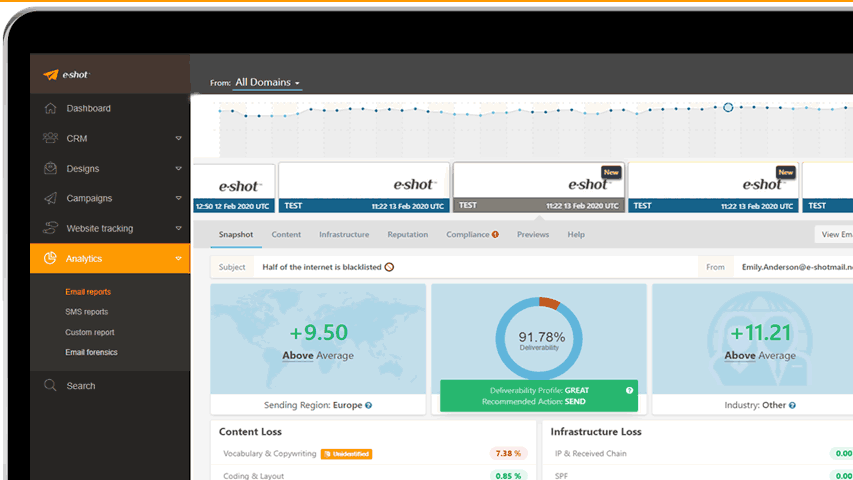Help articles
CATEGORY: Help ArticlesDeliverabilityAnalytics
Deliverability Dashboard
.jpg)
The Deliverability Dashboard gives you a one-stop shop to monitor the health of your account. Here you can see an overview of your activity and reputation, and you will find any areas of possible concern highlighted so that they can be immediately addressed.
At the top of the dashboard, you will find the key information about your account set up including your sending domain details and the details of your VESC.
Sending Domain - The domain or sub-domain, used exclusively for your organisation in the from address (after the @) e.g., john.smith@abc.com, news@comms.department.gov.uk.
VESC - Virtual e-shot™ Sending Client - The domain or sub-domain, used exclusively for your organisation. It is used for the monitored links, link your imagery, opt-out (unsubscribe) link, forward to a friend link and view in web browser link.
Below these details, is a snapshot of the activity in the account over the last 30 days including the number of campaigns sent, the total number of emails sent and the total number of unique contacts that were sent one or more campaigns in this period.

Next, we move to the infrastructure.
Infrastructure
The infrastructure section summarises details of the security and authentication set up on your account. This will be of particular interest if you manage your own domain (ie gov.uk) – but for most, our operations team manages it for for you, so you will be greeted with a sea of green.

Sender Policy Framework (SPF) informs the receiving servers that your server's IP addresses are authorised to send on your behalf and should be trusted for your domain.
Domain Keys Identified Mail (DKIM) verifies via cryptographic key that the email came from an authorised server. e-shot follows the NCSC recommendation to have multiple domain keys which can be rotated periodically. If you see a red exclamation in the DKIM block please contact our customer success team and we will work with you to ensure that the infrastructure is correctly configured.
Domain-based Message Authentication, Reporting and Conformance (DMARC) provides a policy used by the receiving server to determine how to handle unauthorised use of your email domains. We apply the strongest 'reject' (p=reject) policy that ensures that unauthorised email doesn't get delivered. DMARC is also used to generate reports, which provide information and analysis about the systems that are sending email from your domain.
You can find out more information on these in our dedicated article: SPF, DKIM and DMARC demystified
Transport Layer Security (TLS) is an encryption protocol that provides security where email is transferred over untrusted networks, such as the internet. By encrypting with TLS 1.2 or above, we ensure the email's integrity and confidentiality.
Inbox Placement
This section of the dashboard is mostly impacted by your email content. Here we see and overview of your audiences’ reactions to your campaigns and content, both positive and negative. If you see at the top of this section a statement in red, it means that you have been sending multiple campaigns (at least 8), to contacts who never engaged and how many campaigns you send them. This is considered spamming and will directly affect your reputation.
Find out more in our dedicated article: Escape from junk

Engagement: The number of contacts who haven't clicked or viewed your messages over the last 30 days.
Complaints: The number of complaints over the last 30 days.
0-2 Within acceptable limits
2-5 Your sender reputation is at risk
5+ Will adversely affect your sender reputation
Unsubscribes: The number of recipients that unsubscribed over the last 30 days.
0-0.5% Within acceptable limits
0.5%+ Higher than acceptable
Blocklist monitor: A blocklist is a real-time list that identifies IP addresses or domains that are known to send spam. They're used by email providers, cloud mail services, free mailbox providers, and anti-spam vendors to prevent spam from being delivered to their mailboxes.
Find out more in our dedicated article: Blocklisting, what it means and what to do about it.
Sender Score: Sender Score provides an indication of the trustworthiness of an email sender's IP address. Mailbox providers use the sender score to evaluate the reputation of senders to help them determine whether to deliver messages from this IP or domain to the inbox.
80+ You have a great sender reputation
70-79 Continue following industry best practices and optimising your email program
0-69 You need to repair your sender reputation
There are two primary ingredients that determine your sender score - volume and consistency. If you have a regular pattern (frequency and consistency) of sending to constant or steadily number of contacts, in regular intervals, then you will have a good sending score. Your score will also be influenced by complaints (and blocklisting). If you see no sender score in this section, then it is likely that there is not sufficient data for an assessment to be made.

Bounce rate: The bounce rate is the number of email addresses that could not be delivered to, known as hard bounces, out of the total of emails you sent. Your bounce rate represents the health and quality of your contact list.
Full details can be found in Hard bounces vs soft bounces and what to do with them
It is essential that you regularly refresh your list, remove bounced and disengaged contacts. Failure to do so, risks sending to old mailboxes which have been converted to spam traps! and it will adversely affect your reputation.
0-0.5% Within acceptable limits
0.5-5% Improve your contact list health
5%+ Unacceptable level of bounces; you are in breach of our Acceptable Use Policy (AUP)
The industry best practice recommendation and GDPR requires that you have a regular process to keep your list fresh and up to date.
Find out more about data management in https://www.e-shot.net/insights/blog/maintaining-your-email-marketing-database and building a strong sending reputation in When reputation is everything.
We strongly recommend using our data validation service every 3-6 months.
Top 10 domains: The next section highlights the Top 10 domains that you have sent to in the last 30 days and includes the unique number of contacts sent to each of these domains. This information is an important insight to the domain that your deliverability should be tuned for, and it gives you an overview if you are operating an ABM (account-based marketing) strategy.
Useful links: The final section is a selection of useful links, some of which we have mentioned above;
If you have any queries on the data that you see in your deliverability dashboard then our customer success are on hand to assist.
Solutions
Email marketing healthcheck
We are confident that we can help you, which is why we offer a free healthcheck to identify potential issues with your current programme and free advice on things that could be done to improve it.
.jpg)

